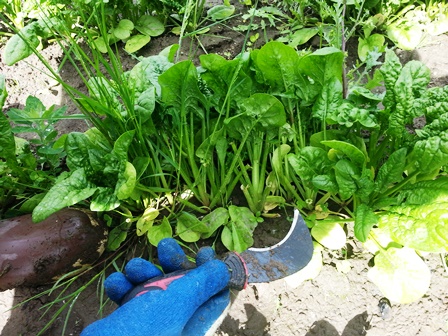Economical harvesting tools can be found anywhere. It is possible to come up with a useful tool for any type of harvesting. When trying to come up with tools they typically fall into two categories: knives and other.
Knives
Knives are extremely useful as they can be very inexpensive and come in a wide range of shapes and sizes that can meet any need. A great place to shop for harvest knives is at any hardware/construction warehouse store. If you have the ability/money to shop at a local hardware store do it, otherwise, Lowe’s and Home Depot are some of the big name places that are everywhere and have relatively inexpensive items. A better place to find inexpensive harvest knives is at Harbor Freight, a discount tool store. Some of the knives that are especially useful are as follows:
-
 Curved linoleum knives are great for making a simple pulling cut to quickly and easily harvest bunched greens such as spinach.
Curved linoleum knives are great for making a simple pulling cut to quickly and easily harvest bunched greens such as spinach.
-
Light serrated knives are essential for quickly harvesting any brassica as they often have a slightly tough exterior skin that must be sawn through.
-
Heavy serrated knives are useful for difficult woody items such as head lettuce, cabbages, and bulb fennel.
All of these items can be found in the above-mentioned stores for very reasonable prices. To find knives for lower prices one could check dollar stores and thrift stores for steak knives and larger kitchen knives, which can stand in for the light and heavy serrated knives. Keep these classifications in mind if you ask your volunteers to bring their own harvesting tools.
Other
Other tools can range from shovels and digging forks to fruit pickers, buckets and harvest bags. Finding low cost shovels and digging forks is possible in thrift stores and re-stores, but if one wishes to find them new they will cost a bit more even at Harbor Freight. A possible way to get some of your tools donated is to approach local hardware stores with the possibility of direct donations or holding a tool drive at their store. If those options do not work you can always create tools. Using buckets is essential for collecting produce in the field and carrying it back to the boxes or vehicle on the edge of the field. Buckets are found all over and are more durable than bags. However, creating harvest bags from canvas bags is a nice option (see other article for how to guide).
.jpg)
Digging tools are difficult to fabricate, as they need to be quite stout. Fruit pickers are not as difficult as all one needs is a stick, wire, and bag. Run the wire through the mouth of the bag either through a seam or tape it if using a plastic bag. Take the resulting bag and with the free ends of the wire fasten it to the end of a stick or pole and viola you’ve got a simple fruit picker. The wire in the bag opening allows you to pop apples and other tree fruit free from the branches and the bag catches the fruit.
Plastic Containers or Clamshells:
Another way to streamline the fruit harvest to distribution process can be had by picking small tree fruit (Apricots, pears, cherries) and soft fruit (berries, kiwis, grapes) directly into distribution containers. Plastic clamshells are widely available in food banking. Ideally one would use new clamshells to pick the fruit directly into. However if used containers are available, be certain to clean and sanitize through a triple wash sink. Volunteers can carry several clamshells nested, pick into the top one, close it when full and place it into a collection box for transport to the food bank and rapid distribution.

 Curved linoleum knives are great for making a simple pulling cut to quickly and easily harvest bunched greens such as spinach.
Curved linoleum knives are great for making a simple pulling cut to quickly and easily harvest bunched greens such as spinach..jpg)
